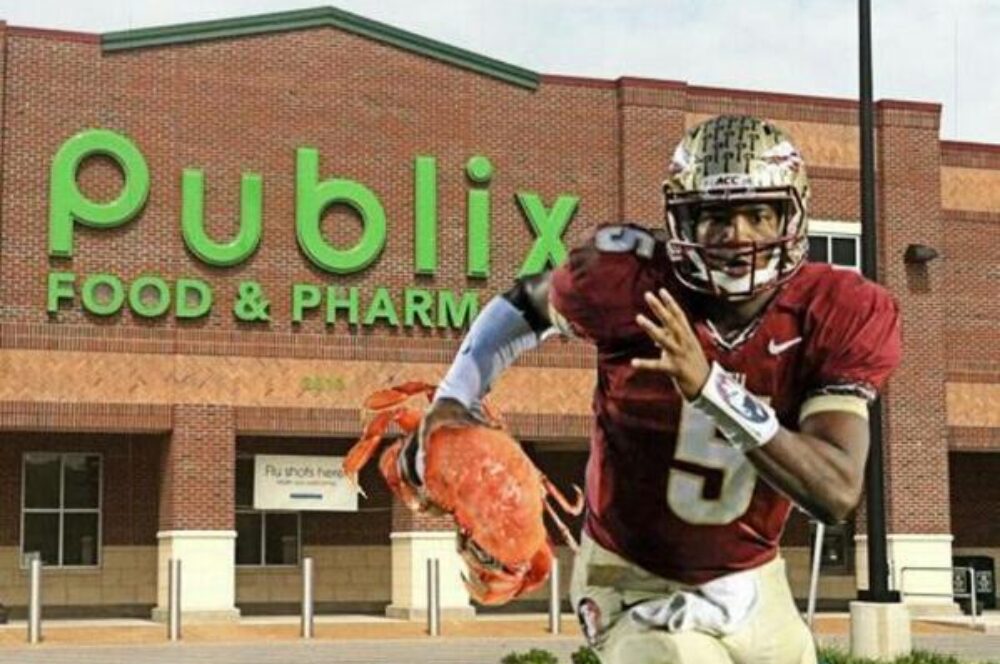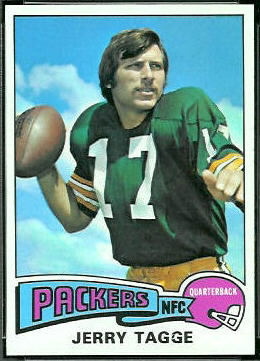Jerry Tagge: Honorable Mention (NFL)
DOESN’T JERRY TAGGE LOOK LIKE A PORNO STAR PRETENDING TO BE A QUARTERBACK CIRCA 1975?
Synopsis: Between the retirement of Vince Lombardi in 1968 and arrival of Brett Favre in 1992, the Green Bay Packers experienced a 24-year period of futility. Of note, they had only five winning seasons and two playoff appearances. Their failure can be attributed to monumentally bad draft decisions. The selection of OT Tony Mandarich with the 2nd overall pick in 1989 has received the most notoriety. However, the team also failed by trading multiple high round draft picks for washed-up QB John Hadl in 1974 and selecting QB Rich Campbell with the 6th overall pick 1981. Perhaps starting the downward cycle, Green Bay took QB Jerry Tagge with the 11th overall pick in 1972. This post focuses on that decision and whether Tagge deserves to be considered an all-time bust.
JERRY TAGGE: HONORABLE MENTION
Due to the retirement of Hall of Fame QB Bart Starr in 1971, the Green Bay Packers needed to find a replacement. In response, the Packers selected Jerry Tagge with the 11th pick in the 1972 draft. As the starting quarterback for the Nebraska Cornhuskers, Tagge won two national championships. Furthermore, he grew up in a suburb of Green Bay. On the surface, he seemed to be the ideal replacement for one of the NFL’s all-time greats.
In the marque match-up of the Tagge’s senior season, he led the #1 ranked and defending national champion Cornhuskers into Norman, Oklahoma to face the #2 ranked Sooners. With tremendous hype surrounding Oklahoma’s record-breaking offense and Nebraska’s defense, SI labeled the match-up, “The Game of the Decade.”
JERRY TAGGE – #1 NEBRASKA VS. #2 OKLAHOMA

In one of the few games that lived up to the media’s excessive hype, Tagge directed a 12-play, 74-yard game-winning drive. Nebraska left Norman with its #1 ranking intact en route to its 2nd consecutive national championship. If the game had occurred 20-30 years later, Tagge would have been a shoo-in for the the Heisman. As support, I offer Gino Torretta in 1992, Charlie Ward in 1993, Eric Crouch in 2001, and Jason White in 2003.
Unfortunately, Tagge lost out to a player who got the award for lifetime achievement instead. In case you doubt that statement, guess which of the following players ended up winning the Heisman that year.
QUARTERBACK STATISTICS FOR 1971 HEISMAN CANDIDATES
| Player | Comp | Att | Yards | TD | INT | Efficiency Rating | Highlights / NCAA Ranking |
| Player 1 | 167 | 281 | 2,586 | 17 | 12 | 148.2 | Sammy Baugh Trophy 4th-Yards 5th-TDs |
| Player 2 | 182 | 325 | 2,262 | 21 | 13 | 127.8 | 6th – Yards 2nd – TDs 8th – Efficiency |
| Player 3 | 154 | 258 | 2,178 | 17 | 4 | 149.2 | 9th – Yards 4th – TDs 1st – Efficiency |
For full disclosure, I offer the following rushing stats for these QBs.
- Player 1: 270 yards, 9 touchdowns.
- Player 2: 66 yards, 2 touchdowns.
- Player 3: 330 yards, 9 touchdowns.
Furthermore, I’ll offer their team records.
- Player 1: 9-2, ranked 10th in final AP poll.
- Player 2: 9-2, ranked 12th in final AP poll.
- Player 3: 13-0, ranked 1st in final AP poll.
GRATUITOUS TIME DELAY

If you said Player 2, you win. Of note, Pat Sullivan won the 1971 Heisman while putting up those numbers. However, you deserve half credit if you said Player 1 because you got the right person but the wrong year. Specifically, Player 1 represents Sullivan during the 1970 season.
In 1970, Sullivan arguably had the best season of any college player. As a junior, however, he may have suffered from a senior bias. Of note, seniors Jim Plunkett (#1), Joe Theismann (#2) and Archie Manning (#3) finishing as the top 3 in the balloting. Based on NFL success, it’s hard to argue with the voters. Then again, picking the player with the best NFL prospects is not the purpose of the honor. That’s the purpose of the draft.
To the extent Sullivan unfairly lost the award in 1970, Tagge could make the same claim in 1971. As Player 3, Tagge outplayed Sullivan. He had better numbers and led his team for a national championship. Still, he only finished 7th in the balloting.
Interestingly, it seems like the reverse bias exists today. Voters have gone away from treating the Heisman as a lifetime achievement award by honoring freshmen and sophomores. Those same voters hold these underclassmen to higher standards in subsequent years. In the last decade alone unsuccessful repeat winners have included Matt Leinart, Tim Tebow, Johnny Manziel, and Jameis Winston.
JERRY TAGGE – FAIRY TALE ENDING?
Despite the results of the 1971 Heisman balloting, Tagge still had the stage set for a fairy tale ending. In particular, the local boy went off and won two national championship before returning home.
Hmm. maybe there is some credibility to LeBron’s tenure in Miami being just like a college sabbatical. As an aside, you may enjoy his own words (well, someone’s words) romanticizing his return home. LeBron may still be living the dream, but the fairy tale didn’t last long for Tagge.
While Tagge might have been a sentimental choice for the Green Bay faithful, he deserved being a high pick based on his successful college career.
JERRY TAGGE – COLLEGE STATS (NEBRASKA)
| Player | Yards | TD | INT | Passer Rating | Rushing Yards | Rushing TD |
| Jerry Tagge | 5,069 | 32 | 20 | 136.3 | 672 | 18 |
Despite his pedigree, Tagge struggled mightily in the NFL. For an article written by Martin Hendricks of the Milwaukee Journal Sentinel, Tagge openly admitted the following.
I was mixed up and had a hard time handling life. I didn’t handle a lot of things well: the money, the fame, everything. So I drank, it was my escape. More than once I was hungover at practice.
I’m sure Tagge wasn’t the only Packer hungover at practice, but he presumably couldn’t handle it as well as the others. Fortunately, his personal demons weren’t exposed to everyone as they would be today. According to Tagge,
That was at a time when you could drink and the police didn’t arrest you; they just drove you home.
When it became obvious that Tagge couldn’t be a franchise quarterback, Packers GM Dan Devine pulled off the 1970s version of Minnesota’s trade for Herschel Walker. Just like Mike Lynn (the Vikings’ GM who traded for Walker), Devine traded his team’s future for a presumed short-term fix. In particular, Devine traded two 1st round picks, two 2nd round picks and a 3rd round pick for John Hadl, a relatively successful but aging quarterback on the Rams.
Whereas Walker actually produced for the Vikings, Hadl had a 7-12 record with nine touchdowns and 29 interceptions during his 1 1/2 years with the Packers. You now should have another reference point for Devine besides him being the curmudgeon who coached Daniel “Rudy” Ruettiger at Notre Dame.
COACH DEVINE FROM RUDY
While Devine distanced himself from the inaccurate portrayal in the movie, he certainly couldn’t distance himself from his boneheaded trade for Hadl. Interestingly, both events were connected because Devine wouldn’t have left for Notre Dame if he had been successful at Green Bay.
It’s hard to believe, but Hadl actually served as an upgrade when compared to Tagge. The following table shows Tagge’s career numbers in the NFL and compares them with Brian Sipe, a 13th round pick from the same draft.
1972 DRAFT – JERRY TAGGE AND BRIAN SIPE
| Player / Draft Pick | Record | Yards | TD | INT | Passer Rating | Weighted Avg Value |
| Jerry Tagge #11 |
6-6 | 1,583 | 3 | 17 | 44.2 | 8 |
| Brian Sipe #330 |
57-55 | 23,713 | 154 | 149 | 74.8 | 70 |
Rushing stats:
- Tagge – 195 yards, 3 touchdowns.
- Sipe – 792 yards, 11 touchdowns.
No one legitimately could have argued that Brian Sipe should have been chosen ahead of Jerry Tagge. Still, it might have saved a lot of pain for the Packers if they had. The team might have avoided the Hadl fiasco as well as the selection of Top 10 Bust Honorable Mention Rich Campbell with the 6th pick in the 1981 draft.
As a bust, Tagge left nothing to be desired. Specifically, he met the following criteria.
- Early 1st round draft pick.
- Bona fide college superstar.
- Horrendous NFL career.
- Personal demons.
- Reverberating negative effect on the team.
But for the Brady Quinn Exemption (i.e. not being drafted with a top 10 overall pick), Tagge certainly would be a Top 10 Bust. I seriously considered the Jerry Tagge Exception to the Brady Quinn Exemption, but the criteria are already complicated enough. Regardless, Tagge justifiably earned an Honorable Mention.






0